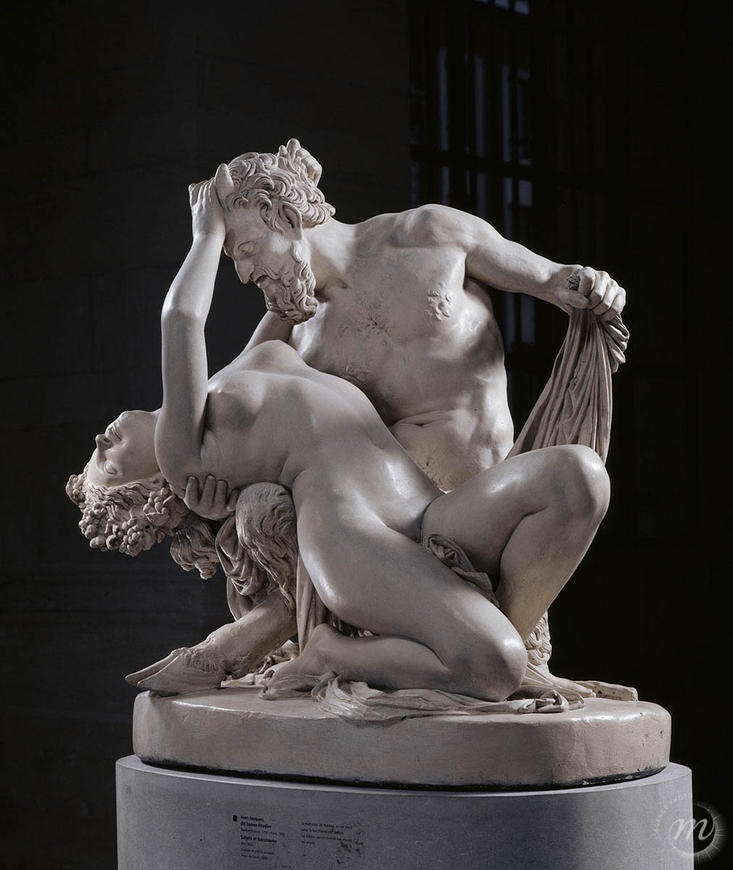When exhibited at the Paris Salon in 1834, this plaster sculpture caused a sensation as much for the subject as for its realistic treatment. Taking the pretext of a mythological subject as his starting point, the artist exalts the beauty and sensuality of the female body, departing from the classical ideal to offer a new, bold and ambiguous style.
To start with, both figures are represented on a human scale. Next, the bodies are sculpted with such attention to detail that the flesh seems malleable and living. The artist delights in detailing each anatomical feature, going so far as to make the stocky satyr's veins and body hair stand out.
The satyr, recognisable by his cloven hooves, is a rural divinity – sometimes confused with the faun – symbolising temptation and desire. Bacchantes are nymphs linked to the cult of Dionysus (or Bacchus). They are always depicted naked or scantily clad, wearing a crown of flowers, dancing or playing music. The two figures are rarely shown together.
This work was shocking for obvious ethical reasons, but also for aesthetic reasons. Belonging to the neo-classical school which was then dominant in French art, Pradier here heralds the arrival of the Romantic movement, presenting with no concessions or false modesty a front-on, erotic vision of the male-female relationship.
Today, the sculptor's audacity and great technical dexterity still bowl us over.
Detail 1. Some people have claimed there is a resemblance between the pretty bacchante and Juliette Drouet, with whom Pradier had a daughter, and who was also the mistress of Victor Hugo.
Detail 2. A recent restoration dislodged some plaster, removing three layers of whitewash added over the years. In the process, nail marks and pencil crosses, markers to be used when cutting the marble, were discovered, confirming the theory that this plaster is the original model used to make the marble held in the Louvre.
(Ref. Sc. 51)

When exhibited at the Paris Salon in 1834, this plaster sculpture caused a sensation as much for the subject as for its realistic treatment. Taking the pretext of a mythological subject as his starting point, the artist exalts the beauty and sensuality of the female body, departing from the classical ideal to offer a new, bold and ambiguous style.
To start with, both figures are represented on a human scale. Next, the bodies are sculpted with such attention to detail that the flesh seems malleable and living. The artist delights in detailing each anatomical feature, going so far as to make the stocky satyr's veins and body hair stand out.
The satyr, recognisable by his cloven hooves, is a rural divinity – sometimes confused with the faun – symbolising temptation and desire. Bacchantes are nymphs linked to the cult of Dionysus (or Bacchus). They are always depicted naked or scantily clad, wearing a crown of flowers, dancing or playing music. The two figures are rarely shown together.
This work was shocking for obvious ethical reasons, but also for aesthetic reasons. Belonging to the neo-classical school which was then dominant in French art, Pradier here heralds the arrival of the Romantic movement, presenting with no concessions or false modesty a front-on, erotic vision of the male-female relationship.
Today, the sculptor's audacity and great technical dexterity still bowl us over.
Detail 1. Some people have claimed there is a resemblance between the pretty bacchante and Juliette Drouet, with whom Pradier had a daughter, and who was also the mistress of Victor Hugo.
Detail 2. A recent restoration dislodged some plaster, removing three layers of whitewash added over the years. In the process, nail marks and pencil crosses, markers to be used when cutting the marble, were discovered, confirming the theory that this plaster is the original model used to make the marble held in the Louvre.
(Ref. Sc. 51)